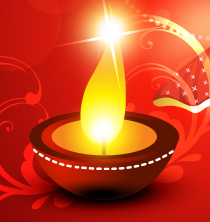Response from Shri Ravi Trehan
Dear Lalit,
May Param Pujya Guruji shower his blessings on you and your framily.
I do not know how your query escaped our attention, hence the delay in responding to it. You have posed a very apt question – what is the significance of lighting 5 diyas at 5 places on Diwali evening. It has both a scientific as well as a spiritual explanation. Scientifically speaking, for various reasons, tremendous amount of pollution is created in the atmosphere. Lighting diyas with mustard oil at different places helps in dissipating the pollution, eradicating its harmful effects and cleaning the atmosphere for well-being of human race and the living organism.
There are strong spiritual and human aspects to it also. Nature has bestowed upon us bountiful gifts for the sustenance of human life on planet earth. It is a call to express our gratitude to these benevolent gifts of Nature and to inculcate a sense of dedication and selfless service.
- Nal – water tap: Water is a life source. Without this essential gift of Nature, it is impossible to imagine life on planet earth. The inherent qualities of water are coolness, purity, transparency, continuous flow and ability to change its course when it comes across any obstacle, so on and so forth. If we imbibe these qualities, we can attain fulfilment of life. By lighting a diya at nal (water tap), we are expressing our gratitude to this wonderful gift of Nature.
- Tulsi : Here is another priceless gift of Nature which has tremendous medicinal values and finds a prominent place in the courtyards of many Hindu homes. It is regarded a very sacred plant. In Yayurveda, shyam varan tulsi has been equated with Sanjeevani booti. Scientific research has revealed that large scale plantation of Tulsi creates a thick ozone layer which protects mankind from various diseases (specially cancer) and dispels many ailments. The rightful usage of its various parts help in eradicating number of diseases. As a normal practice in Hindu homes, diya is lit at Tulsi plant during the entire month of Kartika.
- Peepal: Lord Krishna says in Bhagvad Gita that among the trees, I am Peepal. From times immemorial, Hindus have regarded Peepal as a most holy tree and have been offering jal (water) to it and lighting diyas round the year, especially on Saturdays. Peepal tree emits oxygen during the day and carbon dioxide after the sun set. Lighting diyas of mustard oil at Peepal tree nullifies the effect of carbon dioxide.
- Chauraha – road crossings: Firstly, pollution is maximum at the crossings. Lighting mustard oil diyas at chaurahas (road crossings), minimise the pollution. Secondly, at some crucial junctures of life, for some reason or the other, we find ourselves at the cross roads looking for help and guidance. Metaphorically speaking, lighting of diyas at the crossings is an effort to enlighten the path and extend a helping hand to the needy. Imbibe the feelings of love and compassion for co-travellers in the path of life.
- Shamshaan Ghaat – Cremation ground: This is the ultimate destination of life’s journey and an abode of Lord Shiva. A visit to the cremation ground is a reminder of the ultimate end of our gross body. We must always remember that death is inevitable. So live this life like a spectator with a sense of detachment from the material world and be one with the Lord. Furthermore, like a multitude of living beings, there are multitude of wandering souls. Lighting diyas at the cremation ground also gives solace to the wandering souls and generates positive energy for their salvation.
And finally, such is the configuration of planets and stars on Diwali day that they emit intense cosmic energy. Lighting of diyas with mustard oil at different places also generate positive energy. The fusion of these two energies have a tremendous positive effect for the welfare and wellbeing of all living organism.
As regards Mantra , we have explained at length in our Article – Dhan Teras, posted on the Blog on October 12 & 31, 2013. However, for your ready reference, it is being repeated as follows:
Do japa of the following Lakshmi mantra and thereafter apply tilak at the holy feet of Goddess Lakshmi and Lord Ganesha, while reciting the mantra:
“Aum Hring, Kling, Mahalakshmi Namah”
How many times to recite this mantra, is left to your option. Minimum one mala and maximum 5, 11malas (however, more the merrier).


On namo Shiv omom namo gurudev
Om Namoh Shiv Om Om Namoh Gurudev. Guruji THANKS A TON for such informative , educative , scientific explanation and enlightening answers to the queries.
It has clarified many doubts in me too
Warm regards, Nawal